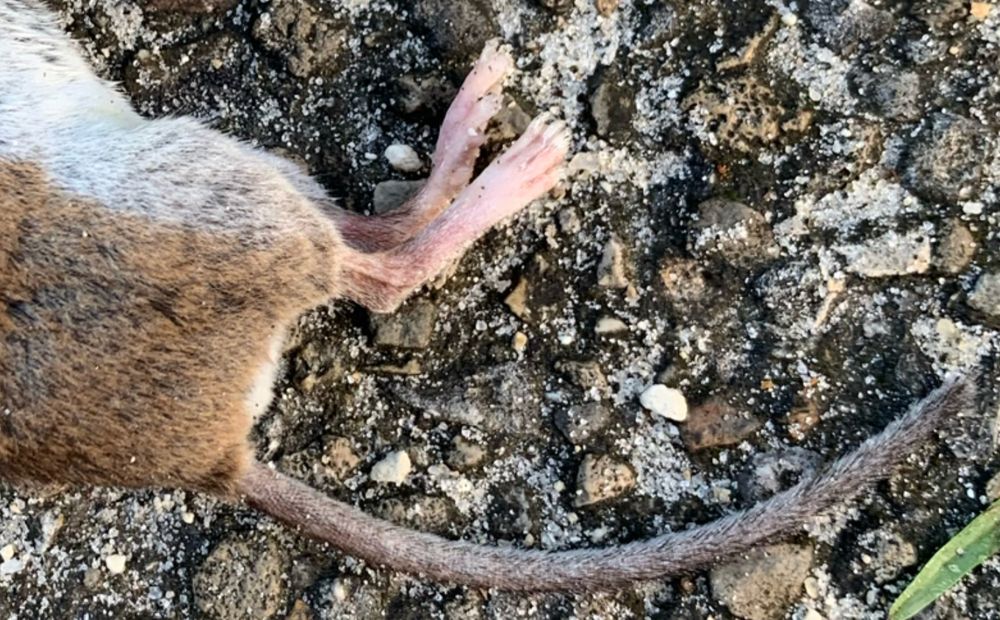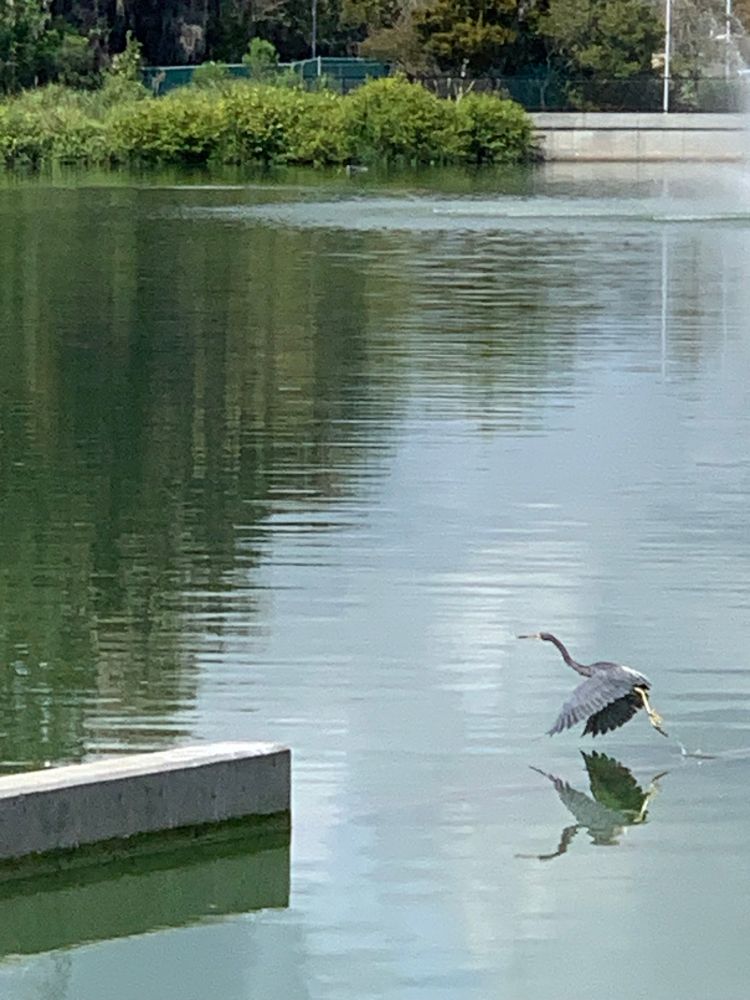I first encountered pilateds while doing fieldwork in a large, remote, protected National Forest, so I was shocked when I moved to Florida and they're just... in my backyard. #birds 🪶

I first encountered pilateds while doing fieldwork in a large, remote, protected National Forest, so I was shocked when I moved to Florida and they're just... in my backyard. #birds 🪶
32. Mourning Dove (Zenaida macroura). The sound that their wings make upon takeoff is potentially used as a signal/cue to other birds about the presence of a predator. (In this case, me and my dog.) #birds 🪶

32. Mourning Dove (Zenaida macroura). The sound that their wings make upon takeoff is potentially used as a signal/cue to other birds about the presence of a predator. (In this case, me and my dog.) #birds 🪶
Only a crop of the picture today, since the whole thing's a little gory. 😔 (Full pic's on iNat if you can help ID, though!) I found it near a house that has a semi-feral cat colony. Keep your cats indoors, folks!

Only a crop of the picture today, since the whole thing's a little gory. 😔 (Full pic's on iNat if you can help ID, though!) I found it near a house that has a semi-feral cat colony. Keep your cats indoors, folks!
Probably a Squirrel Tree Frog (Hyla squirella), but the my windows are too dirty to tell for sure from this angle. Obviously not taken while walking my dog, but since I was already over the 25 spp requirement I counted it anyways. #herps #frog

Probably a Squirrel Tree Frog (Hyla squirella), but the my windows are too dirty to tell for sure from this angle. Obviously not taken while walking my dog, but since I was already over the 25 spp requirement I counted it anyways. #herps #frog
Usually I see ibises in big flocks, or at least groups of 3-4, but this one was foraging in this little creek by itself, although there was a snowy egret nearby. 🪶 #birds #wildlife

Usually I see ibises in big flocks, or at least groups of 3-4, but this one was foraging in this little creek by itself, although there was a snowy egret nearby. 🪶 #birds #wildlife
The best way to distinguish Snowys is their black legs with bright yellow feet. So of course they’re usually wading in vegetation and won’t let you get a good look at their feet. This one was being unusually cooperative, though! #birds #wildlife

The best way to distinguish Snowys is their black legs with bright yellow feet. So of course they’re usually wading in vegetation and won’t let you get a good look at their feet. This one was being unusually cooperative, though! #birds #wildlife
Unlike the alligator, which I legitimately didn’t see until species #20, I see squirrels every day but just kind of forgot that I should take a picture to include them in the project until species #25. Whoops. #wildlife #nature

Unlike the alligator, which I legitimately didn’t see until species #20, I see squirrels every day but just kind of forgot that I should take a picture to include them in the project until species #25. Whoops. #wildlife #nature
Most likely American Crow (C. brachyrhynchos), but we also have the slightly smaller Fish Crows (C. ossifragus) here, and they’re hard to tell apart unless they’re standing next to each other or calling, and this one was alone and silent. #birds #wildlife

Most likely American Crow (C. brachyrhynchos), but we also have the slightly smaller Fish Crows (C. ossifragus) here, and they’re hard to tell apart unless they’re standing next to each other or calling, and this one was alone and silent. #birds #wildlife
(It took off before I could get a real pic.)

(It took off before I could get a real pic.)
What a great descriptive species name! “Many-tongued mimic”: yup, that’s what it is. I heard one once unmistakably mimicking a Scarlet Tanager in a place where no tanagers lived, and always wondered where he learned it from.
#wildlife #bird 🪶

What a great descriptive species name! “Many-tongued mimic”: yup, that’s what it is. I heard one once unmistakably mimicking a Scarlet Tanager in a place where no tanagers lived, and always wondered where he learned it from.
#wildlife #bird 🪶


#bird #egret #wildlife #nature

#bird #egret #wildlife #nature
I remember feeling so betrayed as a young birder upon learning that these are not red-headed woodpeckers. Who’s looking at their bellies?
#wildlife #birds

I remember feeling so betrayed as a young birder upon learning that these are not red-headed woodpeckers. Who’s looking at their bellies?
#wildlife #birds
Like the squirrel, this is another species that I see pretty much every day, but didn't realize until a month into the semester that I should take a picture of it so it could count towards my list.

Like the squirrel, this is another species that I see pretty much every day, but didn't realize until a month into the semester that I should take a picture of it so it could count towards my list.
Conveniently, Turkey Vultures spell out their initials for easy ID even when you can’t see their pink heads. T for the dark part of their bodies vs. wings, and V for how they hold their wings when soaring.
#bird #nature #wildlife


Conveniently, Turkey Vultures spell out their initials for easy ID even when you can’t see their pink heads. T for the dark part of their bodies vs. wings, and V for how they hold their wings when soaring.
#bird #nature #wildlife
Adult tricoloreds look very different from the juveniles. Adults are mostly slaty blue, while the juveniles have a reddish head, neck, and wings. Both have a thin white stripe along the underside of their necks, though. #birds 🪶 #heron


Adult tricoloreds look very different from the juveniles. Adults are mostly slaty blue, while the juveniles have a reddish head, neck, and wings. Both have a thin white stripe along the underside of their necks, though. #birds 🪶 #heron
Following the iNaturalist rules for what counts as wild vs. captive observations (is the animal at that place/time under its own power or because a human put it there), the feral campus cats count towards our class project, although pet cats don't.

Following the iNaturalist rules for what counts as wild vs. captive observations (is the animal at that place/time under its own power or because a human put it there), the feral campus cats count towards our class project, although pet cats don't.
Males are all black (although sometimes with white feathers on their wings or back); females and juveniles have the brown heads. Both have long necks and long stabby beaks for fishing. The female is sitting on a goose decoy (Branta plasticensis).


Males are all black (although sometimes with white feathers on their wings or back); females and juveniles have the brown heads. Both have long necks and long stabby beaks for fishing. The female is sitting on a goose decoy (Branta plasticensis).
‘Tis the season for tiiiiiiny baby anoles. This is another species that every student will have on their list; they’re everywhere, and much easier to spot than the picture suggests.
#lizard #wildlife #nature


‘Tis the season for tiiiiiiny baby anoles. This is another species that every student will have on their list; they’re everywhere, and much easier to spot than the picture suggests.
#lizard #wildlife #nature
I haven’t been able to get a decent photo of this species this semester, so instead you get this video of one of them providing the constant soundtrack to one of our local parks. #bird 🪶
I haven’t been able to get a decent photo of this species this semester, so instead you get this video of one of them providing the constant soundtrack to one of our local parks. #bird 🪶
A tricksy green anole, what with its being brown and hanging out in brown anole places (on the sidewalk). But my subconscious caught the gestalt of the longer head and white jaw and said “wait, check again.”
#nature #wildlife #lizard

A tricksy green anole, what with its being brown and hanging out in brown anole places (on the sidewalk). But my subconscious caught the gestalt of the longer head and white jaw and said “wait, check again.”
#nature #wildlife #lizard
Normally my dog finds box turtles for me, but this one crossing the road was pretty easy to spot, even with my dull human senses.
#wildlife #nature

Normally my dog finds box turtles for me, but this one crossing the road was pretty easy to spot, even with my dull human senses.
#wildlife #nature
I’m slowly getting better at IDing emydid pond turtles but when their carapaces are muddy or covered in algae, I’m out of my depth. At least this one was chill and didn’t immediately hit the water. 🐢

I’m slowly getting better at IDing emydid pond turtles but when their carapaces are muddy or covered in algae, I’m out of my depth. At least this one was chill and didn’t immediately hit the water. 🐢


